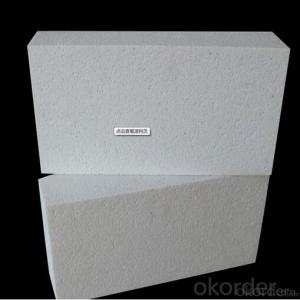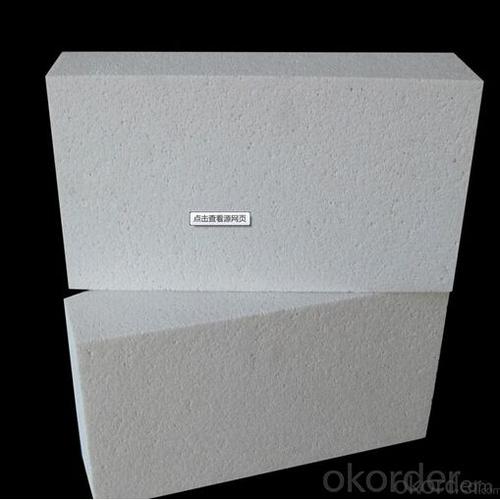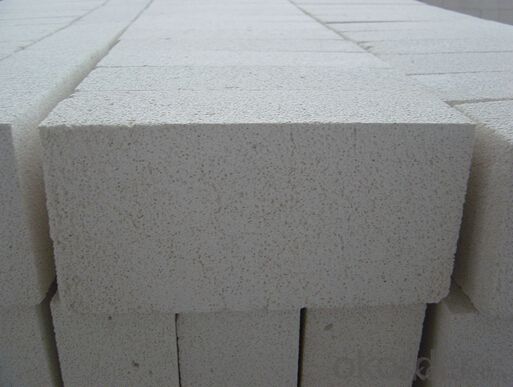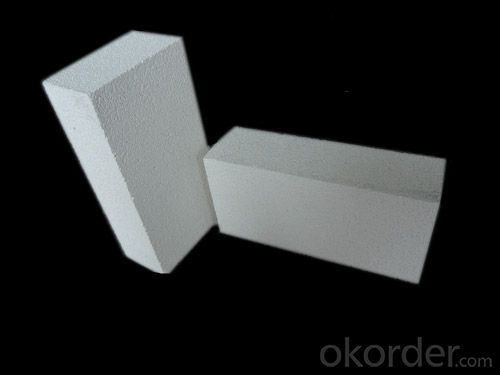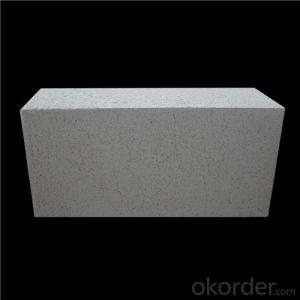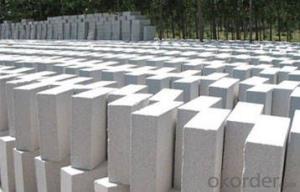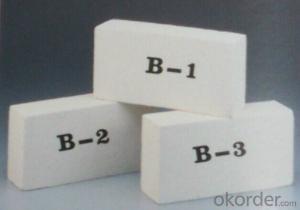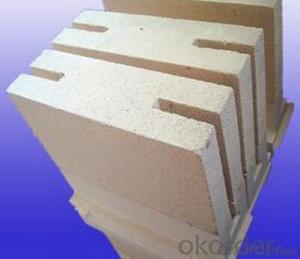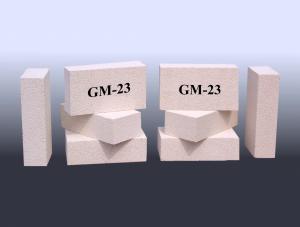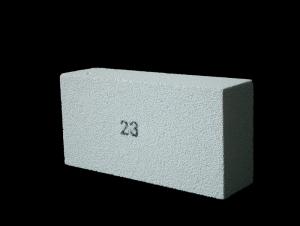Insulating Fire Brick - Refractory Mullite GJM 23
- Loading Port:
- Shanghai
- Payment Terms:
- TT OR LC
- Min Order Qty:
- 5000 kg
- Supply Capability:
- 1000000 kg/month
OKorder Service Pledge
OKorder Financial Service
You Might Also Like
OKORDER Series Insulating Bricks
OKORDER series insulating bricks are a kind of highly efficient, energy saving, low-carbon, environmental protection advanced products which are manufactured according to ASTM standard. OKORDER series products are the best lining and insulation materials in all types of industrial furnaces in the field of Metallurgy, Aluminum, Petrochemical, Ceramics, Power and Glass. They can be applied as heat insulation or no-melt erosion parts of the working layer. The products have been widely used in the following furnaces and achieved satisfactory results.
Application of Insulating Bricks
Metallurgy industry: Blast furnace, Hot blast stove, Reheating furnace, etc.
Petrochemical industry: Ethylene cracking furnace, Hydrogen production furnace, Primary reformer furnace, Reheating furnace, etc.
Ceramics Industry: Roller kiln, Pusher kiln, etc.
Glass industry: Glass furnace regenerator, etc.
Carbon Industry: Carbon roaster, etc.
Aluminum electrolytic industry: aluminum reduction cells,etc.
Other industries: Tunnel kiln, Shuttle kiln, etc.
Advantages of Insulating Bricks
Low Thermal Conductivity: More porosity brings excellent insulation effect, energy saving.
High Crushing Strength: High crushing strength under thermal state, volume stability.
Low Heat Storage: Little thermal storage when absorb more heat, energy saving effect is obvious.
High Purity: Low content of iron, alkaline and metal impurities.
Accurate Dimension: Precise brick size by machining, cutting and grinding special shapes, expediting bricklaying.
Picture of Insulating Bricks
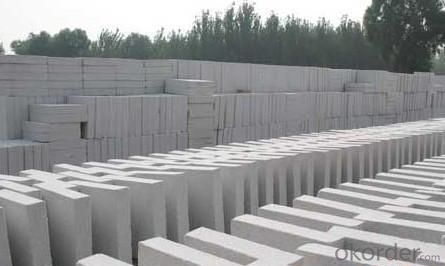
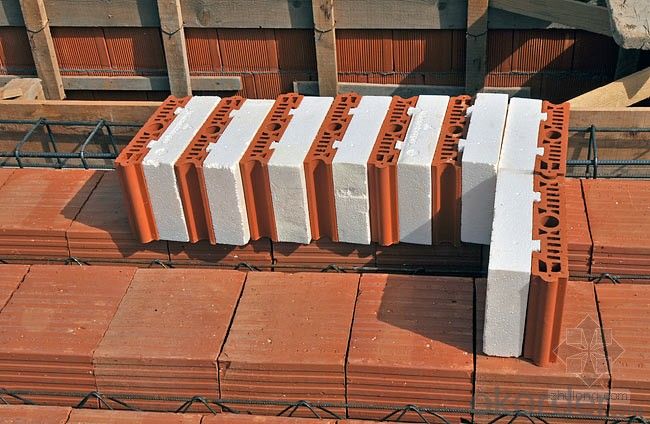
FAQ
1. Which products do you have?
We have all kinds of refractory brick, castable, mortar, cement, ceramic fiber products, etc.
Or you could browse our products to choose what you need.
2. How do you control the products quality?
With strict quality control system throughout the materials selection and production process, our refractory and ceramic fiber products quality is effectively controlled to meet customer requirements.
From the raw materials selecting, our quality control begin. The quality certificates of raw materials are required and each batch will be tested before using. During production, the quality control are conducted by workers and then each piece will be sorted and examined by quality supervise.
3. Can you give me a brief introduction of the application of your products?
We are mainly specializing in the refractory materials in iron and steel, cement, glass, ceramics, petrochemical, electric power Industry, etc.
4. If I need your offer, what information do you need?
In order to choose suitable products, it will be appreciated to provide us the information, such us specification, technical data, order quantity, products application etc.
If any question, please contact us freely.
- Q: Do insulating fire bricks require special storage conditions?
- Special storage conditions are not necessarily required for insulating fire bricks, but it is recommended to keep them in a well-ventilated, dry, and cool area. These bricks are made from lightweight materials that are designed to endure high temperatures and provide heat insulation. However, excessive moisture or exposure to extreme temperatures can potentially impact their performance and durability. It is advisable to shield the bricks from direct sunlight or rain, as extended exposure to these elements might cause harm. Additionally, arranging the bricks in an orderly manner and keeping them away from sharp objects or heavy loads can prevent any potential damage or deformation. In summary, while special storage conditions may not be compulsory, taking appropriate precautions can aid in preserving the quality and lifespan of the insulating fire bricks.
- Q: Are insulating fire bricks resistant to vibration or seismic activity?
- Insulating fire bricks lack resistance to vibration or seismic activity in general. These bricks are intended for insulation purposes, making them lightweight and porous. Although they can endure slight vibrations or low levels of seismic activity, they are not explicitly engineered to withstand substantial shaking or tremors. When facing concerns regarding vibration or seismic activity, it is recommended to utilize bricks or materials that are specially crafted to withstand such forces.
- Q: What are the bubble bricks?
- The requirements for production conditions are not high. Simple shed to plant products without open storage, warehouse, on the quality of workers is not high.
- Q: Do insulating fire bricks have good insulation performance at high temperatures?
- Yes, insulating fire bricks have excellent insulation performance at high temperatures. These bricks are designed specifically to withstand extremely high temperatures and provide a high level of thermal insulation. They are made from lightweight materials that have low thermal conductivity, allowing them to effectively trap and contain heat within a furnace, kiln, or other high-temperature applications. This insulation property helps in reducing heat loss and maintaining a consistent temperature inside the structure. Insulating fire bricks are widely used in industries such as ceramics, metallurgy, glass-making, and heat treatment, where maintaining high temperatures and thermal efficiency are crucial.
- Q: Are insulating fire bricks resistant to thermal shock cracking?
- Insulating fire bricks exhibit resistance against thermal shock cracking. These bricks are engineered to endure elevated temperatures and sudden temperature variations without experiencing cracks. With their low thermal conductivity, they efficiently capture and retain heat while remaining unharmed by thermal shock. Consequently, insulating fire bricks find frequent application in contexts where thermal shock poses a potential hazard, such as furnaces, kilns, and other environments with high temperatures. Their dependable resistance to thermal shock cracking renders them a trustworthy selection for such applications.
- Q: Can insulating fire bricks be used in kilns or furnaces?
- Certainly! Kilns or furnaces can indeed utilize insulating fire bricks. These bricks are purposely constructed to endure elevated temperatures and thermal shock, rendering them exceptionally suitable for kilns or furnaces. Their remarkable insulation capabilities aid in heat preservation and enhance energy efficiency. Moreover, these bricks are lightweight and simple to install, hence their widespread preference for lining kiln or furnace walls and floors. All in all, insulating fire bricks present a dependable and efficient means of upholding high temperatures and guaranteeing optimal performance in kilns or furnaces.
- Q: Can insulating fire bricks be used in high-temperature ducts?
- High-temperature ducts can indeed utilize insulating fire bricks. These bricks are specifically engineered to endure extreme temperatures, making them an optimal option for situations where heat retention and insulation are pivotal. Through their low thermal conductivity and strong resistance to thermal shock, insulating fire bricks are able to effectively trap heat within the ducts, averting any energy loss and ensuring efficient heat transfer. Moreover, their lightweight composition facilitates easy installation and handling, while their durability enables them to withstand the demanding conditions of high-temperature environments. Ultimately, insulating fire bricks prove themselves as a dependable and efficacious solution for the insulation of high-temperature ducts.
- Q: Are insulating fire bricks suitable for insulation in gas turbines?
- Yes, insulating fire bricks are suitable for insulation in gas turbines. They have excellent insulating properties and can withstand high temperatures, making them an ideal choice for protecting and insulating the components of gas turbines.
- Q: Do insulating fire bricks require a refractory mortar for installation?
- Yes, insulating fire bricks typically require a refractory mortar for proper installation. Insulating fire bricks are lightweight and have high insulating properties, making them ideal for applications where thermal efficiency is important. However, due to their lightweight nature, they can be more fragile and prone to cracking or breaking under stress. Using a refractory mortar specifically designed for high-temperature applications helps ensure a strong and durable bond between the bricks. Refractory mortars are formulated to withstand high temperatures and provide excellent adhesion and thermal expansion properties. This mortar helps to create a solid and secure structure by filling in gaps between the bricks and providing additional support. Without the use of refractory mortar, insulating fire bricks may not be properly secured and could shift or separate over time, compromising the integrity of the installation. Additionally, the absence of refractory mortar may result in reduced thermal efficiency due to increased heat loss through gaps and spaces between the bricks. Therefore, it is highly recommended to use a refractory mortar when installing insulating fire bricks to ensure a strong and long-lasting construction.
- Q: Is it possible to cut insulating fire bricks to fit custom shapes?
- Yes, it is possible to cut insulating fire bricks to fit custom shapes. These bricks can be easily cut using a saw or other cutting tools to achieve the desired shape and size for specific applications.
Send your message to us
Insulating Fire Brick - Refractory Mullite GJM 23
- Loading Port:
- Shanghai
- Payment Terms:
- TT OR LC
- Min Order Qty:
- 5000 kg
- Supply Capability:
- 1000000 kg/month
OKorder Service Pledge
OKorder Financial Service
Similar products
Hot products
Hot Searches
Related keywords

